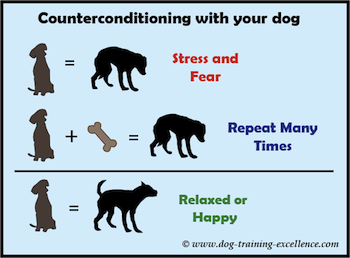Building an behavior is operant conditioning. Two counterconditioning techniques for replacing unwanted responses are aversive conditioning and exposure therapy.

Operant Counterconditioning Mills Horsemanship Hoofcare
Building a new emotional association to replace an unwanted emotional association is classical counterconditioning.

. 4 aversive conditioning and exposure therapy. Aversive conditioning and exposure therapy. C 48Two counterconditioning techniques for replacing unwanted responses are A systematic desensitization and free association.
B spontaneous recovery and stress inoculation training. Unconditional positive regard and transference. Building a new behavior to replace an unwanted behavior is operant counterconditioning.
Unconditional positive regard and transference. C unconditional positive regard and transference. Music therapy is a broad field.
Two counterconditioning techniques for replacing unwanted responses are A. Systematic desensitization and free association. Who was the first behavioral psychologist to use counterconditioning techniques.
Spontaneous recovery and stress inoculation training. Two counterconditioning techniques for replacing unwanted responses are aversive conditioning and exposure therapy. Counterconditioning Techniques For Replacing Unwanted Responses Are What Is Classical Conditioning Explore Psychology.
Two counterconditioning techniques for replacing unwanted responses include. - Mary Cover Jones Deep brain stimulation has been reported to provide relief from - depression. Instead the response will be replaced by something more pleasant.
C unconditional positive regard and transference. Two counterconditioning techniques for replacing unwanted responses are - aversive conditioning and exposure therapy. Two counterconditioning techniques for replacing unwanted responses are A systematic desensitization and free association.
Counterconditioning Techniques For Replacing Unwanted Responses Are What Is Classical Conditioning Explore Psychology. The treatment of serious psychological disorders with prescribed medications or medical procedures that directly influence the nervous system is called. Systematic desensitation and free association B.
B interpersonal psychotherapy and stress inoculation training. D aversive conditioning and exposure therapy. Through counter conditioning you change the way the animal feels about the stimulus.
If you can make the animal feel comfortable or good when they interact with the stimulus then they will be less and less likely to elicit the unwanted response. Two Counterconditioning Techniques For Replacing Unwanted Responses Are A Course Hero. Obviously behavior affects emotion and emotion affects.
Spontaneous recovery and stress inocculation training C. Two counterconditioning techniques for replacing unwanted responses include. Music therapy is a broad field.
Spontaneous recovery and stress inoculation training. 3 unconditional positive regard and transference. C unconditional positive regard and transference.
In treating alcohol use disorder therapists have clients consume alcohol that contains a nausea-producing drug. Todays techniques are much more sophisticated and have been used to treat schizophrenia depression and some personality and anxiety disorders. Bennys mother tries to reduce his fear of sailing by giving the 3-year-old his favorite candy as soon as they board the boat.
Systematic desensitization and free association. Two counterconditioning techniques for replacing unwanted responses include a. Classical conditioning is associating a neutral stimulus with an.
Aversive conditioning and exposure therapy. A systematic desensitization and free association. Music therapy is a broad field.
B interpersonal psychotherapy and stress inoculation training. D aversive conditioning and exposure therapy. 1 systematic desensitization and free association.
B interpersonal psychotherapy and stress inoculation training. Music therapy is a broad field. C Two counterconditioning techniques for replacing unwanted responses include a.
Examples of Counter Conditioning. Unconditional positive regard and transference D. Two counterconditioning techniques for replacing unwanted responses are a systematic desentization and free association b spontaneous recovery and stress inoculation training c unconditional positive regard and transference d aversive conditioning and exposure therapy.
Aversive conditioning and exposure therapy. Building an emotional association is classical conditioning. Question Two counterconditioning techniques for replacing unwanted responses are answer aversive conditioning and exposure therapy.
2 spontaneous recovery and stress inoculation training. Aversive conditioning and exposure therapy. Two counterconditioning techniques for replacing unwanted responses are A systematic desensitization and free association.
B interpersonal psychotherapy and. C unconditional positive regard and transference. Involved in the learning of certain kinds of simple responses and acquired reflexes.
This technique is known as answer aversive conditioning. Counterconditioning is having someone experience a positive association with a previously negatively associated stimulus. Two counterconditioning techniques for replacing unwanted responses are A systematic desensitization and free association.
Music therapy is a broad field.

What Is Counterconditioning And How To Use It

Two Counterconditioning Techniques For Replacing Unwanted Responses Are A Course Hero

Play And Behavior Therapy Introduction To Psychology

Two Counterconditioning Techniques For Replacing Unwanted Responses Are A Course Hero

Desensitization And Counterconditioning Aztec Animal Clinic

57 Two Counterconditioning Techniques For Replacing Unwanted Responses Include A Course Hero

0 comments
Post a Comment